Wednesday, December 4 | 11:40 a.m.-11:50 a.m. | SSK09-08 | Room N228
In this scientific session, researchers from University Hospital Zurich will present the clinical benefits from both PET/MRI and PET/CT for evaluating primary tumors in the pelvic region.Their study enrolled 13 women with different primary and recurrent gynecological diseases. All subjects underwent a trimodality PET/CT/MRI exam (Discovery 690 PET/CT and 3-tesla Discovery 750w MRI, GE Healthcare).
Patients were injected with an average of 320 MBq of FDG prior to a contrast-enhanced MRI of the abdomen and pelvis. After the MRI, patients were transferred for a standard PET/CT scan with or without intravenous contrast media. Acquisition of PET/CT/MRI and PET/CT compared to PET/MRI evaluation was feasible in all patients.
For primary tumors, PET/MRI was superior in five cases, whereas PET/CT was better in only two cases. Regarding lymph nodes, PET/CT was superior in two cases and PET/MRI was also better in two cases. For abdominal metastases, PET/CT again was superior in two cases, but PET/MRI was not better in any instance.
Overall, PET/CT provided additional relevant information in nine cases, primarily concerning distant metastases, while PET/MRI provided additional relevant data in three cases concerning the primary tumor.
The higher accuracy of PET/MRI for primary tumors might affect patient treatment when there is only a local tumor, said lead researcher Dr. Patrick Veit-Haibach from the department of medical imaging.
"However, the protocol we used was a trimodality setup with PET/CT/MRI," he added. "We think this is especially effective, since we can demonstrate there is a benefit in advanced stages of having the PET/CT for detection for distant metastases and the MRI for the local pelvic situation."
"Our next topic will be protocol optimization for whole-body simultaneous PET/MRI for different ob/gyn stages and indications," Veit-Haibach said.




















